We hope that each of you, our readers, will enjoy and appreciate this article we present about these 5 Captivating Caribbean Sea Species. It was our pleasure to gather the information for you. May it provide you with both education and increased awareness.
Certainly, these few species listed herein represent only a portion of the similar marvels in this region. It’s our belief, though, that they serve as excellent representations of the wonders that exist here. Check out some of our other articles for similar marvels.
Staghorn Coral
Staghorn Coral Facts
- Starting off this article about these 5 Captivating Caribbean Sea Species we present the stunning wonder known as the Staghorn Coral.
- This distinctive marine invertebrate most frequently goes by the unique, but descriptive, common name that we’ve used herein. Unlike the majority of species, for the moment, this marvel does not possess any other generally accepted common name.
- Among scientific professionals, however, it’s typically referred to by its technical name. Fortunately, that’s a relatively simple term, at least as such things go. That’s because this remarkable creature bears the formal name of the Acropora cervicornis.
- It received this formal name due to the work of the respected French naturalist, Jean-Baptiste Pierre Antoine de Monet. He made the first official recognition of the creature as a separate and distinct species. This scientifically noteworthy event occurred in 1816.
- Unfortunately, though, the population of this wonderful species has been declining rapidly since around 1970. This further seems to hold true throughout the entirety of its range. The IUCN, therefore, now lists the animal as Critically Endangered.
- Multiple projects to attempt to preserve the Staghorn Coral, however, remain underway. The aptly-named Coral Restoration Foundation, along with other organizations, spearhead most of these. Sadly, however, results have so far been minimal.
- This product of evolution also faces threats from numerous factors. These include a particularly virulent coral disease. Pollution of its habitat also constitutes a severe danger. The greatest threat it faces, however, most likely consists of climate change.
Staghorn Coral Physical Description
The magnificent Staghorn Coral easily fascinates those fortunate enough to encounter it. It also does this in several ways. That’s due to the unique fact that, unlike some of its kindred, this product of Nature and evolution impresses in both size and overall appearance.
Although corals come in all shapes and sizes, this one perhaps ranks among the most unusual. That’s due to its evolved pattern of physical development. This member of its Order manifest numerous cylindrical, upward growing branches, not unlike some trees.
These further develop as highly elongated, comparatively thin structures. Each of these also branches out, often having multiple smaller branches. Depending on the age of the individual these vary in length from as little as 2 in (5 cm), to more than 6.5 ft (2 m).
Among older specimens of the Staghorn Coral, these same branching structures also attain an average thickness measuring 1 – 3 in ( 2.5 – 7.5 cm). These same portions of the coral typically angle upward, and rise upward from a single, comparatively hard trunk.
As a general principle, the marvelous Cnidaria additionally displays a remarkably consistent pattern of coloration. This mainly consists of either a pale brown or golden tan shade. That’s further enhanced, however, by the presence of comparatively short, bright white tips.
- Kingdom: Animalia
- Phylum: Cnidaria
- Class: Hexacorallia
- Order: Scleractinia
- Family: Acroporidae
- Genus: Acropora
- Species: A. cervicornis
Staghorn Coral Distribution, Habitat, and Ecology
Unfortunately, both for the Staghorn Coral itself, and for those who appreciate Nature, it inhabits a relatively limited portion of the marine waters of the world. Research also indicates that the species never possessed a more extensive zone of habitation.
That habitat range includes a small portion of the northern Atlantic Ocean. The most northerly part of that range, though, only extends to the east coast of Florida, in the United States. From there, it extends to the Bahamas and the Caribbean Islands.
A limited, disjointed population also appears in the western Gulf of Mexico. In all areas in which it lives, however, it displays the same, decidedly clear preference for where it makes its home. It generally appears in reefs, with other corals, rarely appearing alone.
Yet the wonder of Nature also displays a strong preference for extremely shallow depths. This usually places it close to the shoreline. More precisely, it sometimes lives directly at the shoreline. At its deepest, though, it’s never seen at depths of more than 98 ft (30 m).
Another aspect of its nature also distinguishes the Staghorn Coral from most of its brethren. That’s due to the fact that it displays the fastest known growth rate of all corals of its type in its region. Its many branches often grow as much as 7.9 in (20 cm) per year.
This marine marvel alsp reproduces both asexually and sexually, with the former being the dominant method. This occurs when branches break off and reattach to the ocean floor. Sexual reproduction, however, also happens, typically in either August or September.
Oceanic whitetip Shark
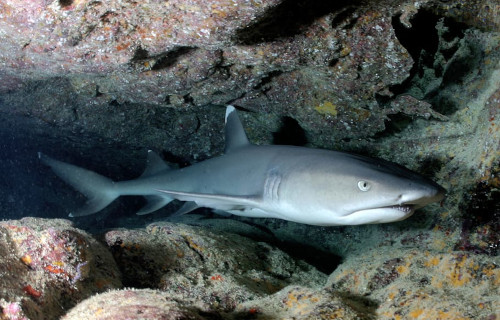
Oceanic whitetip Shark Facts
- Next up among our choices for inclusion in this article about 5 Captivating Caribbean Sea Species comes the impressive Oceanic whitetip Shark.
- This majestic yet nonetheless dangerous predator of the depths frequently goes by the common name for the obvious reason. Yet, it also holds less often used titles. These include such terms as nigano shark, brown shark, and simply whitetip shark.
- Within the scientific community, however, it’s better known by its formal moniker. But that’s an extremely hard name to pronounce for the layperson. That’s because this marvel of nature bears the complex technical title of the Carcharhinus longimanus.
- A degree of controversy persists inside the halls of science, though, concerning that appellation. The first known formal description of the fish occurred in 1831, due to the work of the French naturalist, René-Primevère Lesson, who gave it a similar name.
- The next description of it, however, took place in 1861, at the hands of the Cuban zoologist, Felipe Poey. He also provided it with a similar yet different moniker. Given this confusion, and still others, the name used here is generally the most accepted.
- Sadly, the population of the remarkable Oceanic whitetip shark measures quite small. It also appears to be continuing to diminish. That state apparently holds true throughout its range. The ICUN thus currently lists the fish as Critically Endangered.
- It faces numerous threats to its existence. Most of these stem from the actions of man. They include such factors as being actively fished for its meat and fins. The creature also now faces the dual dangers posed by habitat loss and ongoing climate change.
Oceanic whitetip shark Physical Description
The mesmerizing Oceanic whitetip shark immediately captivates many who encounter the animal in its native environment. Unlike some species, though, it does so for several reasons. That’s due to the fact that it’s visually impressive due to both its appearance and size.
In that respect, the shark follows a pattern common to many of its relatives. That’s true since it displays a certain degree of the physiological characteristic known as sexual dimorphism. In its specific case, this trait manifests itself purely in terms of physical measurements.
More precisely, the female of the species attains a slightly greater overall size than her male counterparts. This gender of the intriguing fish reaches an average body length of roughly 12.8 ft (3.9 m). These further grow to an average body mass equaling 374.8 lb (170 kg).
Males, however, only attain an average length of body measuring about 9.8 ft (3 m). They do tend to have a slightly stockier build than the females, though. Due to this general development, their body mass is an only slightly lighter average of about 368 lb (167 kg).
In terms of overall appearance other than this, however, both sexes of the Oceanic whitetip shark remain virtually indistinguishable at a glance. The upper body of the fish typically displays a gray-bronze shade. Its lower body, though, generally shows an off-white shade.
Yet it’s the fins of the animal that serve as the source of the common name. Most of these display a bright white tip. Each also presents a mottled pattern among adults, and black in younger specimens. A patch resembling a saddle somtimes appears between two dorsal fins.
- Kingdom: Animalia
- Phylum: Chordata
- Class: Chondrichthyes
- Order: Carcharhiniformes
- Family: Carcharhinidae
- Genus: Carcharhinus
- Species: C. longimanus
Oceanic whitetip shark Distribution, Habitat, and Ecology
The fascinating Oceanic whitetip shark evolved as native to an extremely broad swathe of the globe. The full extent of that zone of habitation might surprise some people, though. That’s because this wonder lives in oceans worldside between latitudes 45 N and 43 S.
The vast majority of this range of appearance consists of relatively to extremely deep waters. The creature also displays decided preferences for the temperature of the waters it lives in, as well. It seems to favor temperatures above 68F (20C), and up to approximately 82F (28C).
Yet it also shows some flexibility in this regard. That’s true since a certain percentage of observed specimens appeared in waters with a temperature of about 59F (15C). The animal does, however, seem to studiously attempt to avoid temperatures lower than this.
Despite mainly living in regions of great depths, though, it spends most of its time in the upper layers of the ocean. Most sightings occur at depths of no greater than 490 ft (150 m). Though most individuals stay offshore, some venture into areas as shallow as 120 ft (37 m).
The beautiful Oceanic whitetip shark typically lives a primarily solitary life. Small, temporary groups do sometimes form, however, for hunting and feeding purposes. The animal also evolved as an active hunter, swimming and seeking out prey by both day and night equally.
As a general principle, it usually feeds on a variety of cephalopods, like small squid, and bony fish, such as oarfish and barracuda. Yet it sometimes varies this, adopting a more flexible diet. At these times, it eats such prey as stingrays, birds, crustaceans, and sea turtles.
Loggerhead Sea Turtle
Loggerhead Sea Turtle Facts
- The third entry into this compilation of 5 Captivating Caribbean Sea Species, the Leatherback Sea Turtle, is the only reptile among the group.
- The most notable statistic about the truly magnificent marine reptile remains the readily apparent fact that it ranks as a legitimate giant of its kind. In point of fact, this truly fabulous animal presently lists as the largest of all known living turtles.
- This remarkable and quite impressive creature also constitutes the fourth heaviest of all living reptiles. Only three of the modern crocodilians surpass it in terms of sheer weight, which remains quite an accomplishment for it.
- The fascinating animal further distinguishes itself from all other sea turtles in another manner, as well. This holds true since the amazing sea reptile represents the only known species of its kind that does not possess a bony shell.
- Sadly, however, the Leatherback Sea Turtle now finds itself facing threats to its existence. As a result, the IUCN now lists it as Vulnerable, on its Red List of Threatened Species. The main threats include chemical and plastic pollution, and boat strikes.
- Most regrettably, the estimated number of nesting females among this reptile has plunged dramatically since 1980. At that time, these numbered about 115,000. Currently, however, that number has dropped to fewer than 43,000.
Leatherback Sea Turtle Physical Description
Without question, in the minds of many, the mature Leatherback Sea Turtle represents a truly impressive sight to see. Some impressive individuals reach a total length of as much as 7.2 ft (2.2 m), and achieve a weight often reaching as much as 1,540 lb (700 kg).
Coincidentally, this breathtaking animal also has the longest front flippers of any turtle. These out-sized appendages average an astonishing length of 8.9 ft (2.7 m). That measurement makes them the longest both in sheer length and relative to body size.
In coloring, the fabulous reptile also displays a dual pattern to its appearance. Its upper carapace typically shows a combination of black and dark gray, while the underside of the body generally presents a significantly lighter color scheme.
It is the outer covering of the Leatherback Sea Turtle, however, that separates it from all others. That’s due to an amazing divergence of evolution. Instead of a bony shell, this creature has a covering of extremely thick, tough leathery skin to protect it.
- Kingdom: Animalia
- Phylum: Chordata
- Class: Reptilia
- Order: Testudines
- Family: Dermochelyidae
- Genus: Dermochelys
- Species: D. coriacea
Leatherback Sea Turtle Distribution, Habitat, and Ecology
It must be pointed out that, thankfully, the marvelous Leatherback Sea Turtle has an almost global range. The majority of its population occurs in the tropical and subtropical oceans. Its range, however, extends from the Arctic Circle to Cape Agulhas, in Africa.
Its population numbers, though, appear to be mainly concentrated in three primary populations. Not only that, but each of these remains slightly genetically distinct from the others. These occurs in the Atlantic, western Pacific, and eastern Pacific oceans.
Each of these do share many of the same traits, however. Firstly, all prefer to inhabit the open ocean. Secondly, all tend to follow their prey as it moves during the day. This often results in it moving from deep water during the day to shallower regions at night.
In an interesting twist, juveniles typically prey on various small species for their food, while the adults feed almost exclusively on various types of jellyfish. In contrast, mature adults has few natural predators. The few include orcas and large sharks.
Despite all these facts, the Leatherback Sea Turtle is perhaps best known for its nesting practices. Although most of its kind return to the exact beach of their birth, it remains less selective. For it, any beach in the same region seems to serve perfectly well.
Queen Conch
Queen Conch Facts
- As the royalty in this gathering of 5 Captivating Caribbean Sea Species, the Queen Conch certainly merits its own natural appreciation.
- The term it goes by perfectly serves as the currently accepted common name of a particularly beautiful variety of sea snail. The name of the animal itself, however, remains a source of some confusion, and even a small amount of controversy.
- That’s due to the fact that the mollusk has gone by other scientific names in the past. The original official name for the creature was Strombus gigas. But, that later changed to the distinctive term Lobatus gigas. Now, though, it stands at Aliger gigas.
- Its first official recognition as a distinct species occurred in the year 1758. This took place at the hands of the renowned Swedish naturalist Carl Linnaeus. His choice of name for the creature held true for more than 200 years, until modern times.
- Quite fortunately, for the moment, the Queen Conch does not appear on the IUCN Red List of Threatened Species. This situation exists because it appears to still have a sufficient population base. That, however, could easily change in the future.
- That’s due to the fact that many experts consider it to be facing multiple threats to its safety as a species. One of these consists of over fishing through commercial activities. Yet another remains habitat loss. But its greatest threat remains climate change.
Queen Conch Physical Description
The actual body of the amazing Queen Conch attains a highly respectable size, compared to related creatures. The overall length, though, varies significantly, even among individuals, as it moves. This obviously makes precise measurements difficult to acquire.
The body has some distinct physical characteristics, however. For one, the soft body possesses a head provided with an elongated snout. This also serves as the home of two eyestalks. The animal displays two tentacles, and a single, large part known as the foot.
But the shell of the fascinating Queen Conch represents its most fascinating feature. This varies in size, since it grows as the animal itself does. The shells of adults range from 5.9 – 12.2 in (15 – 31 cm) in length. These also reach an average weight of about 5 lb (2.3 kg).
This portion of the impressive gastropod also has a beautiful appearance. It generally grows in a strong spiral shape. A mature specimen usually displays 9 – 11 whorls. The exterior typically presents shades of tan or brown. But the inside appears a glossy orange or pink.
- Kingdom: Animalia
- Phylum: Mollusca
- Class: Gastropoda
- Order: Littorinimorpha
- Family: Strombidae
- Genus: Aliger
- Species: A. gigas
Queen Conch Distribution, Habitat, and Ecology
The magnificent Queen Conch inhabits a comparatively broad swathe of the world’s oceans. That area’s quite complicated, though. More specifically, the northern edge of this range includes the Western Atlantic coasts of both North America and Central America.
Meanwhile, the southern edge of its range includes the Caribbean tropical area. Unconfirmed reports also extend that range to the northeastern shores of Brazil, in South America. This zone of habitation also includes numerous islands where it appears.
Wherever individuals appear within this range though, these have specific requirements for their choice of habitat. Specimens typically reside in warm shallow water. This region usually consists of regions with a depth measuring no more than 70 ft (21 m).
The stunning Queen Conch also evolved as benthic in nature, meaning it lives on the ocean floor. Most commonly, it prefers to inhabit such regions as areas of seagrass beds. Yet it also often appears among coral reefs and various sandy stretches where these are unavailable.
While some related creatures evolved as hermaphroditic in nature, that’s not the case for this one. This member of its Family possesses two sexes, and reproduces via internal fertilization. After mating, the female lays as many as an astounding 300,000 eggs.
Sei Whale
Sei Whale Facts
- Closing out this listing of these 5 Captivating Caribbean Sea Species we give you the largest of them by far, the majestic Sei Whale.
- This very simple moniker serves as the most frequently used common name for this remarkable mammoth of the seas. The impressive creature does have other titles, though, These include such names as the pollack whale and the Rudolphi’s rorqual.
- Within scientific circles, however, the animal’s much better known by its formal title. That’s a somewhat hard to pronounce term for the layperson, though. That’s because this wonder of evolution bears the official moniker of the Balaenoptera borealis.
- The mammal received that name due to the efforts of the French naturalist, René-Primevère Lesson. He accomplished the first official recognition of it as a separate and distinct species. He managed this scientifically noteworthy deed in the year 1828.
- It’s a massive species, ranking as the third largest extant animal on the planet. Despite its great size, though, it’s also one of the fastest of all cetaceans. Fortunately, this wonder of Nature and evolution is now protected by multiple international treaties.
- Even though it now enjoys protection, it still has a population base that’s significantly smaller than in previous centuries. That lamentable condition extends throughout the entirety of its natural range. The IUCN, thus, now lists it as Endangered on its Red List.
- It faces multiple threats to its continued existence. Most of these stem either directly or indirectly from the actions of humans. Illegal hunting still continues in some regions. Its greatest danger, though, most likely comes from ongoing climate change.
Sei Whale Physical Description
The magnificent Sei Whale easily impresses those individuals fortunate enough to view one. Unlike some creatures, however, they do so for more than just one reason. This masterpiece of evolution garners attention due to both its beauty and sheer physical measurements.
Like many of its relatives, it also displays a certain degree of the physiological characteristic of sexual dimorphism. In its specific case, that trait manifests itself in terms of pure size. More precisely, females of the species attain a greater size than their male counterparts.
Intriguingly, sizes of both genders varies depending upon what portion of its range they live in. Overall, though, males attain a maximum average length of approximately 61 ft (18.6 m). In the same region of the globe, females reach an average length equaling 64 ft (19.5 m).
Weights also vary between the different portions of its range, in both genders. But, in general, individuals weight between 33,069 – 44,093 lb (15,000 – 20,000 kg). Exceptional individuals do occur, of course, regardless of gender. Few exceed these sizes by much.
In terms of appearance, both sexes of the Sei Whale present the same general color scheme. The majority of the body displays a dark, steel gray hue. The underside, though, often presents small, irregular white or light gray markings, as well as sometimes the front.
The beak of the impressive creature usually develops as highly pointed in shape. The pectoral fins of the animal also develop as comparatively short. Each further displays a sharply pointed tip. It also possesses a pair of blowholes, just like most other baleen whales.
- Kingdom: Animalia
- Phylum: Chordata
- Class: Mammalia
- Order: Artiodactyla
- Family: Balaenopteridae
- Genus: Balaenoptera
- Species: B. borealis
Sei Whale Distribution, Habitat, and Ecology
The intrepid Sei Whale evolved as native to an extraordinary range of the marine waters of the world. That’s due to the fact that it appears in most oceans of the earth, as well as adjoining seas. The animal does, though, generally avoid tropical and polar waters.
Like many of its relatives, it additionally engages in seasonal migrations. Individuals typically relocate from colder to warmer regions for winter, and cooler one’s for summer. Even today, however, researchers remain uncertain of the precise routes the amazing whales take.
The majestic Cetacean also displays decided preferences in its choice of precise habitat. Due to this pattern, the vast majority of sightings occur in deeper marine regions. Individuals rarely stray into shallower regions near shore, or even semi-enclosed bodies of water.
Most commonly, this marvel of the seas travels singly. Small pods do form sometimes, though usually temporarily. When such groups do form, they rarely exceed six individuals. Researchers still know very little about the social structure of such short-term groups.
The Sei Whale evolved as a filter feeder, again like many of its relatives. Each specimen consumes an average of 2,000 lb (907 kg) of food per day. Its filtering action primarily catches vast quantities of zooplankton, along with a small number of tiny fish.
Mating occurs in either temperate or subtropical waters during the winter period. Females typically give birth to a single calf, most commonly every 2 – 3 years. Both genders reach sexual maturity at 8 – 10 years of age. A typical lifespan for both sexes is roughly 65 years.
5 Captivating Caribbean Sea Species
We hope that each of you enjoyed reading, and hopefully learning from, this article we’ve written about these 5 Captivating Caribbean Sea Species. It’s also our hope that doing so has left you with either a new or renewed appreciation for such wonders of Nature.
Unfortunately, however, many of their kindred around the world now find themselves facing strong threats to their continued existence as a species. Many of those dangers, in fact, stem from the actions of mankind. We must do all we can to protect and preserve them all.
Check out our other articles on 4 Remarkable Reptiles of Australia, Wonderful Wild Cats of the World, 5 Amazing Moths of Asia, The Mighty Tornado
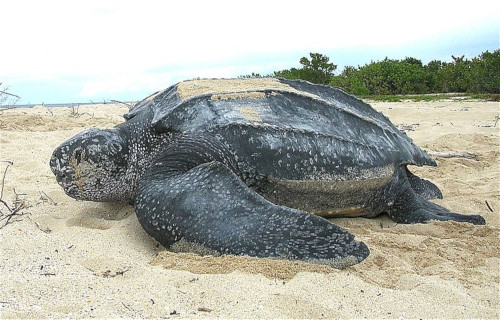
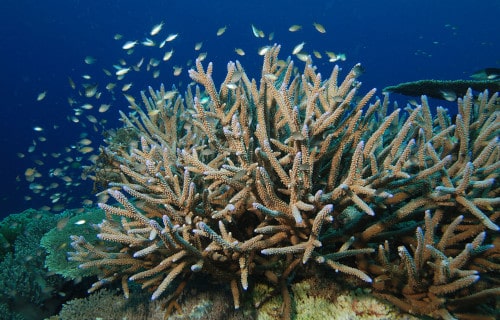
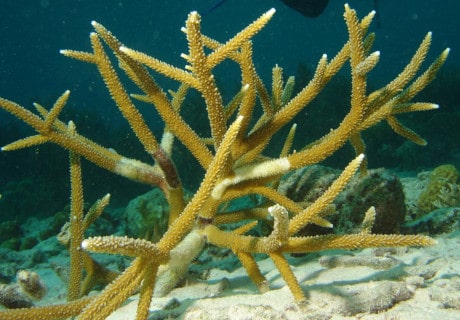
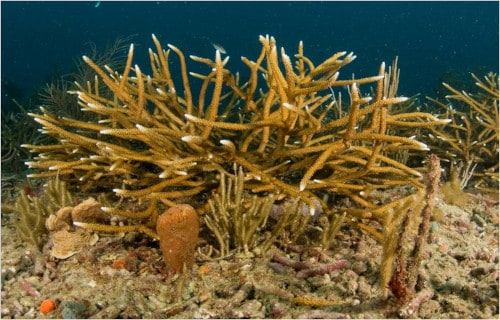
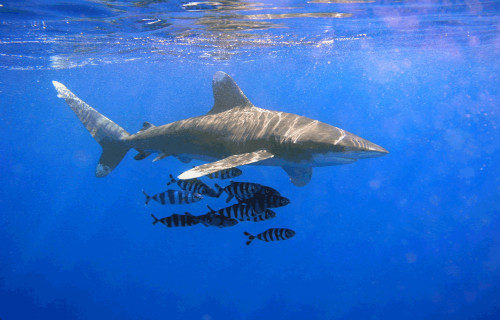
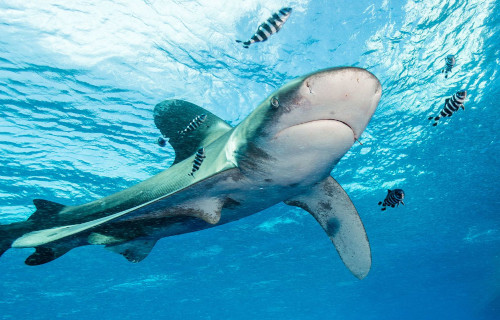
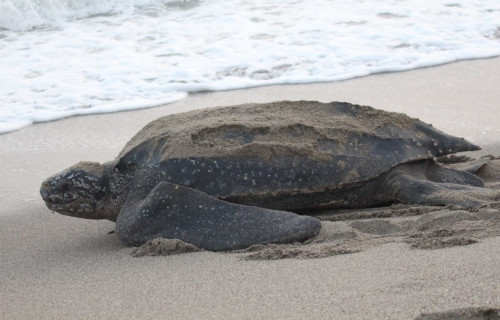
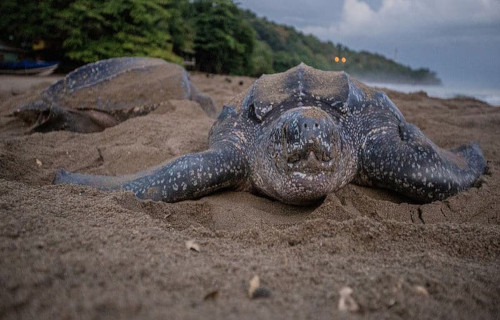
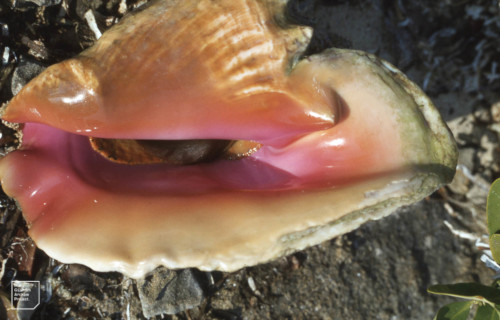
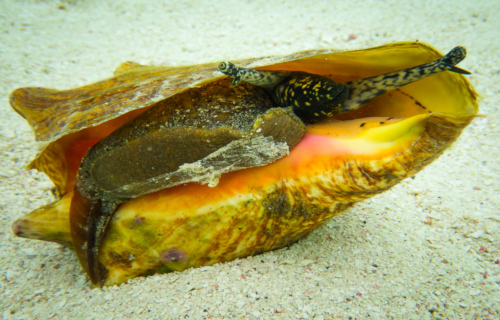
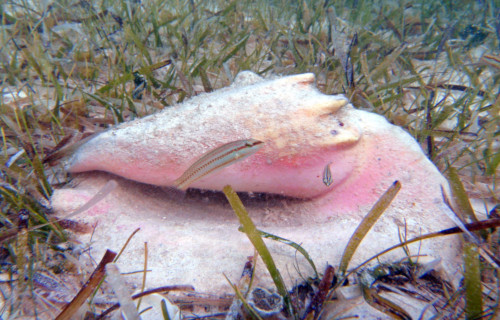
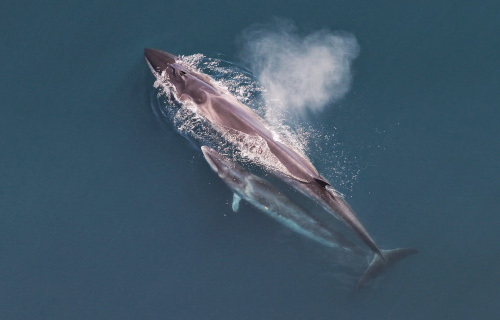
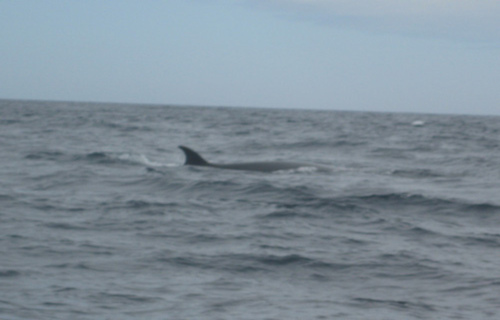









Leave a Reply